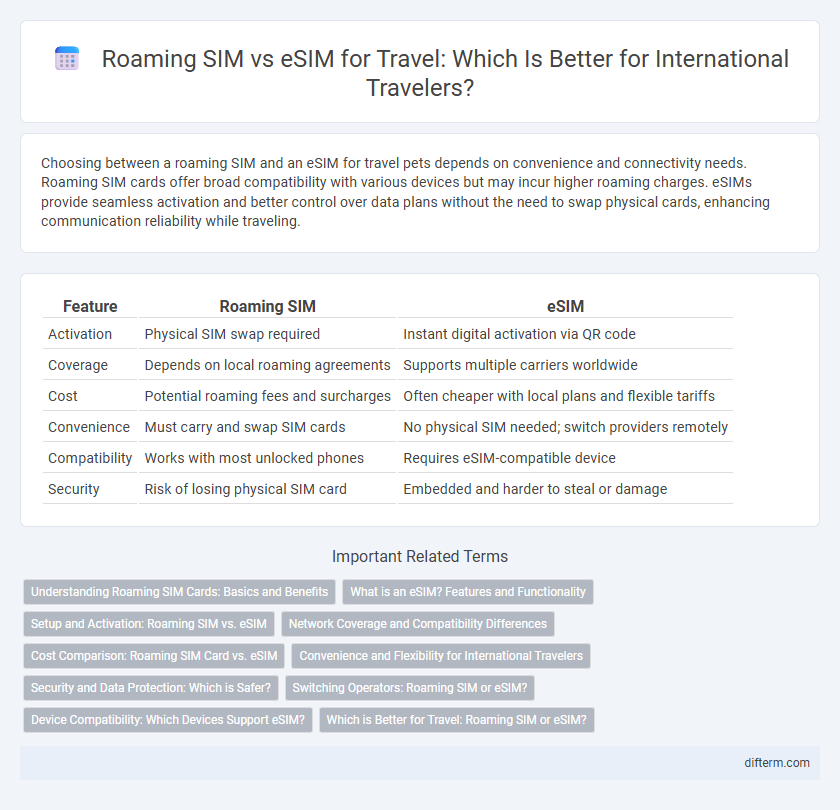Choosing between a roaming SIM and an eSIM for travel pets depends on convenience and connectivity needs. Roaming SIM cards offer broad compatibility with various devices but may incur higher roaming charges. eSIMs provide seamless activation and better control over data plans without the need to swap physical cards, enhancing communication reliability while traveling.
Table of Comparison
| Feature | Roaming SIM | eSIM |
|---|---|---|
| Activation | Physical SIM swap required | Instant digital activation via QR code |
| Coverage | Depends on local roaming agreements | Supports multiple carriers worldwide |
| Cost | Potential roaming fees and surcharges | Often cheaper with local plans and flexible tariffs |
| Convenience | Must carry and swap SIM cards | No physical SIM needed; switch providers remotely |
| Compatibility | Works with most unlocked phones | Requires eSIM-compatible device |
| Security | Risk of losing physical SIM card | Embedded and harder to steal or damage |
Understanding Roaming SIM Cards: Basics and Benefits
Roaming SIM cards enable travelers to use local mobile networks abroad without incurring high roaming fees, offering cost-effective connectivity and easy access to data, calls, and texts. These physical SIM cards support multiple international networks, providing flexibility and reliable service in numerous countries. Benefits include simplified billing, enhanced network coverage, and avoidance of expensive pay-as-you-go rates typical with home carrier roaming plans.
What is an eSIM? Features and Functionality
An eSIM is a programmable embedded SIM that eliminates the need for a physical card, allowing travelers to activate multiple cellular plans remotely without swapping SIMs. It supports instant network switching, enabling seamless connectivity across different countries and carriers while reducing roaming costs. Advanced features include remote provisioning, enhanced security, and compatibility with the latest 4G and 5G networks for reliable global internet access.
Setup and Activation: Roaming SIM vs. eSIM
Roaming SIM cards require physical insertion and may involve manual network selection, which can delay activation and setup for travelers in foreign countries. eSIMs, embedded directly into the device, enable instant activation via QR code scanning or carrier app configuration, streamlining network connectivity without swapping physical SIMs. This instant setup reduces travel disruptions and supports multiple profiles for seamless international use.
Network Coverage and Compatibility Differences
Roaming SIM cards provide extensive network coverage by connecting to local carriers in multiple countries, but compatibility depends on the physical SIM slot availability in devices. eSIM technology offers superior flexibility with virtual profiles that support a wide range of global networks without needing physical SIM swaps, enhancing seamless connectivity across regions. Device compatibility varies as some older models may not support eSIM, while nearly all mobile devices with SIM slots can use roaming SIM cards.
Cost Comparison: Roaming SIM Card vs. eSIM
Roaming SIM cards often incur higher costs due to international roaming fees and limited data packages, leading to unpredictable charges during travel. eSIM technology offers more cost-effective solutions with customizable plans, allowing travelers to purchase local or regional data packages directly on their devices without physical SIM swaps. This flexibility reduces overall expenses, making eSIMs a budget-friendly option for frequent international travelers seeking transparent and controlled connectivity costs.
Convenience and Flexibility for International Travelers
Roaming SIM cards often require physical swapping and can lead to connectivity gaps, while eSIMs offer instant activation and seamless switching between multiple international carriers directly from the device settings. eSIM technology enhances convenience by eliminating the need to carry multiple SIM cards, allowing travelers to manage plans and data usage efficiently on a single device. This flexibility reduces costs and ensures uninterrupted service across borders, making eSIMs an ideal choice for frequent global travelers.
Security and Data Protection: Which is Safer?
eSIM technology provides enhanced security through embedded encryption and remote provisioning, reducing the risk of SIM card theft or physical tampering common with traditional roaming SIMs. Roaming SIMs can be vulnerable to cloning and loss, whereas eSIMs enable instant deactivation and reprogramming, offering better protection for travelers' personal data. Data protection is strengthened with eSIMs thanks to centralized management and fewer points of physical attack, making them a safer choice for international travelers.
Switching Operators: Roaming SIM or eSIM?
Switching operators with a roaming SIM requires physically replacing the SIM card, leading to potential downtime and inconvenience during travel. An eSIM allows travelers to switch operators instantly via software without needing a new physical card, offering seamless transitions between networks. This flexibility makes eSIM the optimal choice for frequent travelers seeking hassle-free connectivity across multiple countries.
Device Compatibility: Which Devices Support eSIM?
Most modern smartphones, including recent models from Apple, Samsung, and Google, support eSIM technology, enabling seamless carrier switching without physical SIM cards. Devices like the iPhone XS and later, Google Pixel 3 and above, and Samsung Galaxy S20 series and newer offer built-in eSIM functionality ideal for travelers. However, older phones and many budget models still rely solely on traditional SIM cards, limiting compatibility with eSIM services.
Which is Better for Travel: Roaming SIM or eSIM?
Roaming SIMs offer convenience by using your existing number and network but often incur higher roaming fees and limited data packages. eSIMs provide flexible, instant access to local carriers with competitive rates and multiple profiles on a single device, ideal for frequent travelers seeking cost efficiency and connectivity. For travel, eSIM technology generally outperforms roaming SIMs by enabling seamless switching between networks without physical SIM swaps or additional hardware.
roaming SIM vs eSIM Infographic

 difterm.com
difterm.com